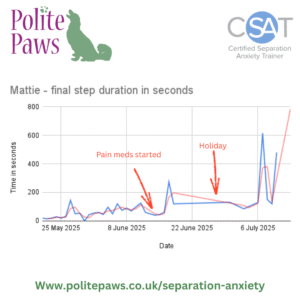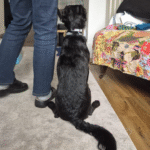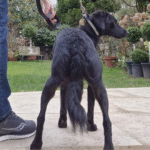Pain has a profound impact on a dog’s behaviour, with D. Mills (a leading veterinary researcher) et al (2020) stating that at least 80% of behaviour cases that they see in clinic have undiagnosed pain.
Why is this important?
The International Association for the Study of Pain (IASP) defines pain as “an unpleasant sensory or emotional experience typically caused by, or resembling that caused by, actual or potential tissue injury”. This definition shows that pain incorporates not just physical sensations, but also involves emotional distress, therefore it is a vital factor to take into account when addressing behavioural concerns with dogs.
D. Mills et al (2020) states that many behavioural issues are either directly linked to, or exacerbated by, pain and when this pain is managed it can result in a considerable reduction of the behaviour causing concern, or in many cases there can be a complete resolution of the behaviour concern, simply by addressing the pain.
Behavioural concerns should NOT be viewed as separate to medical issues. In fact behaviour is often the first (and sometimes only) indication that there is a underlying medical issue.
With separation anxiety in particular, the vast majority of dogs I work with DO end up having some form of pain/musculoskeletal issue diagnosed via my Dynamic Dog assessments that I conduct for all clients (whereby I assess dogs for potential signs of pain). Pain significantly reduces tolerance in dogs, it can make them feel more anxious in general due to the pain, and therefore will mean that their tolerance and ability to cope with stressors such as being alone (because yes, that is a stressor for a lot of dogs, even if they cope fine with being alone) will be much lower than if that pain were absent.
I will add that these Dynamic Dog assessments are NOT in anyway meant to replace the involvement of the vet! Unfortunately in the majority of circumstances, dogs do not show a pain response during a veterinary examination, due to multiple factors (the dog is nervous/excited so adrenaline masks the pain, the pain often isnt shown simply by manipulation but may be shown in other ways such as their posture when they go to the toilet, how they move on grass versus concrete, their posture or behaviour when getting on and off the sofa etc)
Let’s take a recent example…
Mattie

Mattie is a rescue who was with her lovely person for 5 months before we started working together on her separation anxiety. After noticing abnormalities with her gait while watching her on Zoom, and after collating various videos and photos to conduct the Dynamic Dog assessment, I sent a report to the vet who agreed with my observations. Mattie was bought in 2 days later for imaging, and it was discovered she had hip dysplasia. She was immediately put onto a suitable pain medication. This was approximately a month after starting working with me (it always takes time to get suitable photos and videos to asses!)
I want to add that Mattie was NOT lame. She was still running round on walks. She was not “depressed” or crying in pain. She appeared a happy dog.
Prior to this, Mattie had really struggled with her alone time. And while we had managed to get her to the point where she didn’t follow to the door for every single step of her daily plans, we hit a plateau whereby she couldn’t cope with much more than a minute or so of alone time, and even for that time she wasn’t fully relaxed.
Now while regressions and plateaus are common in separation anxiety work (behaviour is never linear), when there are regular set backs for which there are no variables that account for them, this indicates another factor is at play – and this is why I assess ALL dogs right from the word go for any potential signs of pain, so that if so I can communicate my observations to the vet to aid in their investigations
After being on the pain meds for a couple of weeks (during which time Mattie’s mum also had a week off for holiday (with Mattie), the improvement in Mattie’s tolerance during alone time was huge. She has started staying chilled out when her mum goes out of the door, and is currently coping beautifully with absences of around 10 minutes. A huge increase on her previous 1 minute maximum! Her behaviour has also been much more relaxed, often remaining in her bed for the whole time, or taking herself back to bed!
It is still early days and it has only been a month or so since she was diagnosed and since pain meds were started, but already the change is huge
Also, its not just her behaviour when alone that has shown improvement. Prior to diagnosis, Mattie was very nervous and “jumpy” outside the home, often becoming startled at moving leaves or the like. Now that has significantly reduced – with no work done to address this behaviour, simply by Mattie’s pain being managed successfully!
Below is a graph of Mattie’s progress so far. I cant wait to see her progress even further!

Its not just Mattie!
As I said previously, most dogs I work with show postural adaptations or gait abnormalities which indicate there could be some pain or discomfort, and the majority of these dogs are then diagnosed with something that is causing pain. Unfortunately even if your dog has had a vet check in regards pain, and has been given the ‘all clear’ it doesn’t mean there is not pain there. More often than not signs of pain are not seen in a manual vet exam, but rather in ways you might not expect…such as how a dog positions themselves when they sit or lie down, how they get up after a period of rest, how they navigate and cope with daily activities etc.
Most dogs who have chronic pain will still do all of the normal “dog” activities – and it can be hard to feel that a dog who still runs around on walks, plays with other dogs, jumps on and off the sofa is in pain. But dogs have an extremely high tolerance for pain, and it is estimated that by the time a dog is limping, the pain is at least a 7 out of 10.
So we really should be educating ourselves, and responding to the more subtle signs that show a dog may be in pain, especially if that dog is displaying unusual or problematic behaviour.
Certain postures are not “normal”
Below are some photos of dogs I have worked with who are all showing postural signs of pain. If your dog adopts these kind of postures they should be fully checked out. Please dont let anyone tell you that it is “normal” for that breed/breed mix…it is not:
- Sitting/lying down “wierdly” (legs rotated to outside of body/stretched out behind or to the side/sitting on one hip)





- Standing with arched back / Standing with hind legs held very wide.


- Different looking fur on certain areas (ie zigzag patterns, changes of direction of fur)



I hope you can now understand why assessing for, and ruling out pain is really important when working on addressing behaviour in dogs. If pain is not considered then it is quite likely a vital part of the puzzle is going to be missing. Pain could absolutely be a huge causational factor in a dog who displays anxiety about being home alone.
To find out more about the Dynamic Dog assessments I offer please visit:- Dynamic Dog Assessment – Identify Pain & Behavioural Causes
If you would like help working through your dog’s separation anxiety, or have concerns your dog may be in pain and would like to organise a Dynamic Dog assessment, please get in touch! If you complete the form on the page linked below, I will be in touch to arrange an initial call to have a chat: Remote Online Separation Anxiety Dog Training (politepawsdogtraining.co.uk)
Angela Doyle
2025




